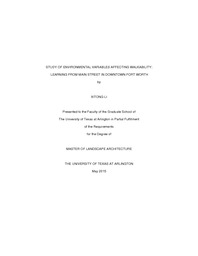
ATTENTION: The works hosted here are being migrated to a new repository that will consolidate resources, improve discoverability, and better show UTA's research impact on the global community. We will update authors as the migration progresses. Please see MavMatrix for more information.
Show simple item record
| dc.contributor.author | Li, Xitong | en_US |
| dc.date.accessioned | 2015-07-31T22:10:19Z | |
| dc.date.available | 2015-07-31T22:10:19Z | |
| dc.date.submitted | January 2015 | en_US |
| dc.identifier.other | DISS-13177 | en_US |
| dc.identifier.uri | http://hdl.handle.net/10106/25116 | |
| dc.description.abstract | Walking has widely been considered by researchers to be important for physical health and a key to increasing social interactions in the local community (Layden, 2003), as well as a mode of transportation in such an era of high fossil fuel price (Maibach, 2009). The negative effects of low-density, automobile-dependent, segregated-use patterns of land and transportation systems typical of postwar suburban development are attracting public health attention. As a result, more designers and urban planners are beginning to take the concept of "walkable design" into consideration in their projects. In order to promote walking activity in terms of urban design, potential needs of study on the relationship between physical environmental variables and an individual's walking activities have been identified by many researchers (Saelens et al., 2003; Brownson et al., 2009). The purpose of this research is to study the impact of environmental variables affecting walkability. This research identifies the environmental variables accounted in design literature, and assesses their impacts on the relationship between walking activity and build environment in Main Street, Fort Worth. A comprehensive literature review has been done on the associations between environmental variables and walking activity, as well as the measures for walkability level. This research adopts quantitative methods to understand environmental variables impacting walkability in Main Street, Fort Worth. Data collection methods primarily involve walkthrough survey of 25 users who are selected as a result of convenient sampling. The research also uses passive observation techniques, and review of secondary and archival data with the Graphic Information Systems (GIS) to further delineate physical environment in downtown Fort Worth. The data analysis is the triangulation of the data collected from various sources to identify and asses varying impacts of environmental variables. The results of the research show the various environmental variables and conditions of the built environment influence walking activity. The findings from this research provide insight into how landscape architects can better understand the interaction between the built environment and walking behavior in influencing each other. This research can help landscape architects and other design professionals in their future design projects to develop and choose more walkable urban design alternatives by predicting walking activity and providing suggestions on improvements of walkable urban spaces. | en_US |
| dc.description.sponsorship | Ozdil, Taner R. | en_US |
| dc.language.iso | en | en_US |
| dc.publisher | Landscape Architecture | en_US |
| dc.title | Study Of Environmental Variables Affecting Walkability: Learning From Main Street In Downtown Fort Worth | en_US |
| dc.type | M.L.A. | en_US |
| dc.contributor.committeeChair | Ozdil, Taner R. | en_US |
| dc.degree.department | Landscape Architecture | en_US |
| dc.degree.discipline | Landscape Architecture | en_US |
| dc.degree.grantor | University of Texas at Arlington | en_US |
| dc.degree.level | masters | en_US |
| dc.degree.name | M.L.A. | en_US |
Files in this item
- Name:
- LI_uta_2502M_13177.pdf
- Size:
- 7.203Mb
- Format:
- PDF
This item appears in the following Collection(s)
Show simple item record


